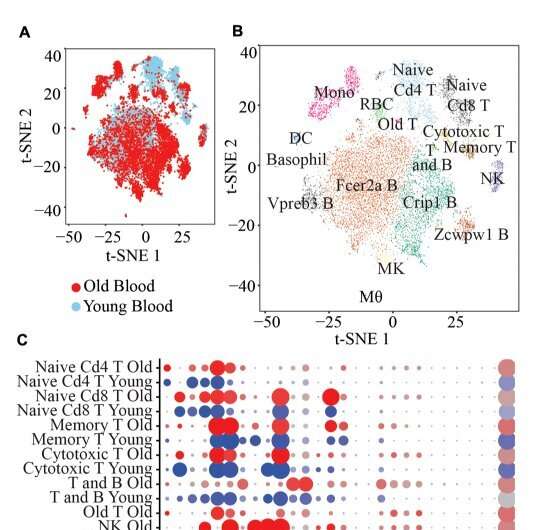This article has been reviewed according to Science X's editorial process and policies. Editors have highlighted the following attributes while ensuring the content's credibility:
fact-checked
proofread
Single-cell transcriptomics of peripheral blood in the aging mouse

A new research paper was published on the cover of Aging entitled "Single-cell transcriptomics of peripheral blood in the aging mouse."
Compositional and transcriptional changes in the hematopoietic system have been used as biomarkers of immunosenescence and aging. In this new study, researchers Yee Voan Teo, Samuel J. Hinthorn, Ashley E. Webb, and Nicola Neretti from Brown University used single-cell RNA-sequencing to study the aging peripheral blood in mice and characterize the changes in cell-type composition and transcriptional profiles associated with age.
"The functional decline of the immune system with age, or immunosenescence, is associated with different hematopoietic changes, including a decrease in the replication ability of hematopoietic stem cells and B lymphopoiesis, and lower efficiency in CD4 and CD8 T cells response," they write.
The team identified 17 clusters from a total of 14,588 single cells. They detected a general upregulation of antigen processing and presentation and chemokine signaling pathways and a downregulation of genes involved in ribosome pathways with age. In old peripheral blood, the researchers also observed an increased percentage of cells expressing senescence markers (Cdkn1a, and Cdkn2a). In addition, a cluster of activated T cells exclusively found in old blood was detected, with lower expression of Cd28 and higher expression of Bcl2 and Cdkn2a, suggesting that the cells are senescent and resistant to apoptosis.
"Finally, targeting senescent cells using genetic approaches has been shown to ameliorate the aging phenotype. More recently, senolytics drugs are being identified or developed to target apoptotic pathways because senescent cells are known to be apoptosis-resistant. Therefore, the Bcl2+ old T cells that we identified in old mice can potentially be targeted pharmacologically to ameliorate the phenotypes associated with the aging of the immune system," the researchers conclude.
More information: Yee Voan Teo et al, Single-cell transcriptomics of peripheral blood in the aging mouse, Aging (2023). DOI: 10.18632/aging.204471
Provided by Impact Journals LLC





















